![]()
![]()
![]()
Use LEFT and RIGHT arrow keys to navigate between flashcards;
Use UP and DOWN arrow keys to flip the card;
H to show hint;
A reads text to speech;
62 Cards in this Set
- Front
- Back
- 3rd side (hint)
|
ISLAM
(general information) |
* Islam vs. Muslim
* Death of the Prophet Mohammed 632 * Holy cities : Mecca and Medina * Qur'an is completion of Christian religion. Jesus is considered a prophet. * Non-muslims : "People of the book" * No figural art in sacred works- calligraphy becomes a hallmark of islamic art. |
|
|
|
MOSQUES
(general information/ vocabulary) |
* Ka'ba : The focal point of Muslim prayer. Prayer is oriented toward the Ka'ba, the direction faced is called the Quibla.
* Quibla wall: The wall in the mosque that faces the Quibla, the Ka'ba, Mecca, etc. * Mihrab: semicircular niche inthe Quibla wall that indicated the Quibla. * Hypostyle: A hall in which the roof is supported by rows of columns. * Muezzin: The chosen person at a mosque who leads the call to prayer. * Minaret: The tower from which the Muezzin issues the call to prayers. * Imam: The chosen person who leads prayers and gives sermons at a given mosque. * Minbar : The pulpit from which the Imam stands to deliver sermons. |
|
|
|
UMAYYAD DYNASTY
|
* 661-750
* 661: first visual expression of islamic power. * Capital: Damascus * Sect: Sunni * Ethnicity: Arabic * Ruler: Caliph |
* "Confidence" most striking feature of Umayyad art. Military successes abroad, secure dynastic power. "Propagandistic" "Experimental"
|
|
|
ABBASID DYNASTY
|
* 750-1258
* Capital: Baghdad/Samarra * Sect: Sunni * Ethnicity: Arabic (persian influences) * Ruler: Caliph |
* Decadent!
* $_____$ |
|
|
FATIMID DYNASTY
|
* 921-1171
* Capital: Cairo * Sect: Shi'a * Ethnicity: Arabic (move to north africa) * Ruler: Amir |
* Missionary
* Rivaling Abbasids |
|
|
GREAT SALJUK DYNASTY
|
* 1037-1194
* Capital: Baghdad (1055) but nomadic * Sect: Sunni (Sufi/Mystic) * Ethnicity: Persian/Turkish * Ruler: Sultan |
* Nomadic
* Mystic |
|
|
ATABEG SUCCESSOR STATES
|
* general: 1100-1300
* localized power, not central |
* Saljuks of Rum: konya/iconium, turkish/byzantine
* Artuqids * Zangids * Ayyubids |
|
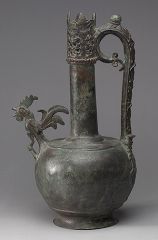
ewer of marwan II
|
* ummayad (661-750)
* unnatural representation of natural objects, characteristic of islamic art. architectural arcade, floriate, rooster on spout, etc. * compare to sculptures at khirbat al-mafjar |
|
|
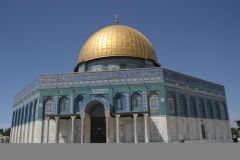
dome of the rock
|
* umayyad (661-750) - completed 691
* jerusalem, isreal * temple mount - sacred judaic site, where herod/david/solomon's temple was. restricted building, could not enter unless muslim. * a trophy to celebrate victory, claims ownership in a strong and visual way. expression of the wealth of the umayyad caliphate. |
|
|
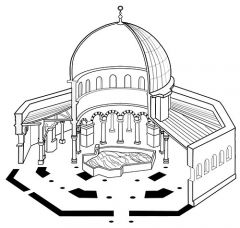
dome of the rock (floorplan)
|
* umayyad (661-750) - completed 691
* jerusalem, isreal * central plan, double aisled. rock in middle external statement rather than internal statement. associate with roman mausolea, adaptation of existing forms. |
|
|
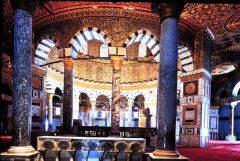
dome of the rock (interior)
|
* umayyad (661-750) - completed 691
* jerusalem, isreal * spolia: reused architectural elements. * lack of relation between the structure of the building and its decoration |
|
|

dome of the rock (mosaic)
|
* umayyad (661-750) - completed 691
* jerusalem, isreal * use of mosaics associated with the byzantine empire. byzantine mosaics directed by umayyad workshop masters. recognizable imagery but extremely unrealistic: winged helmet, sessanian crown. |
|
|
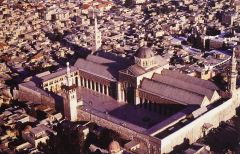
great mosque of damascus
|
* umayyad (661-750)
* damascus, syria * patron: al-Walid I. * temple > church > mosque. standard mosque plan + basilica. aisles run parallel to the quibla wall. long central nave = T plan. * "christian architecture islamicized" |
|
|
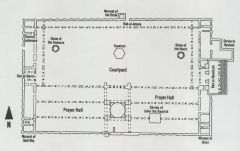
great mosque of damascus (floorplan)
|
* umayyad (661-750)
* damascus, syria * patron: al-Walid I. * temple > church > mosque. standard mosque plan + basilica. aisles run parallel to the quibla wall. long central nave = T plan. |
|
|
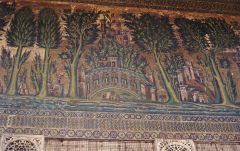
great mosque of damascus (mosiac)
|
* umayyad (661-750)
* damascus, syria * aniconic, continuous frieze of architectural, landscape, motif. mosques, churches, and temples, mansions, barns, etc. peaceful world under dar al-Islam. odd disjunctions of perspective from roman/byzantine tradition. |
|
|
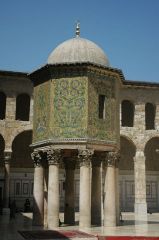
great mosque of damascus (treasury)
|
* umayyad (661-750)
* damascus, syria * site of the mosaic with architectural/landscape motif |
|
|
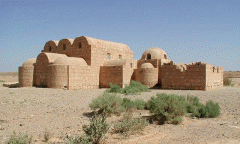
qasr amra
|
* umayyad (661-750)
* jordan * patron: al-Walid * only surviving aspect is the bath house. 3 rooms with 3 different temperatures of water. + princely reception area. |
|
|
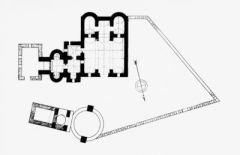
quasr amra (plan)
|
* umayyad (661-750)
* jordan * patron: al-Walid * only surviving aspect is the bath house. 3 rooms with 3 different temperatures of water. + princely reception area. * desert palaces: villa rustica + frontier fort. reworked roman types. non-functional defensive structures. |
|
|
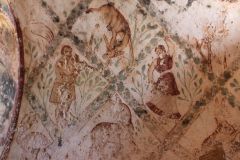
qasr amra (princely entertainments fresco)
|
* umayyad (661-750)
* jordan * patron: al-Walid * no more mosiacs, frescoes. overall subject matter is princely entertainments: hunting, music, dancing girls, drinking, gymnastics/wrestling. |
|
|
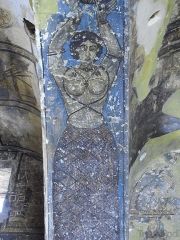
qasr amra (dancing girl fresco)
|
* umayyad (661-750)
* jordan * patron: al-Walid * no more mosiacs, frescoes. overall subject matter is princely entertainments: hunting, music, dancing girls, drinking, gymnastics/wrestling. |
|
|
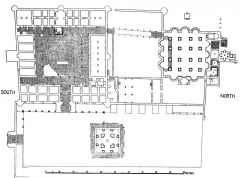
khirbat al-mafjar
|
* umayyad (661-750)
* syria * palace of al-Walid II |
|
|
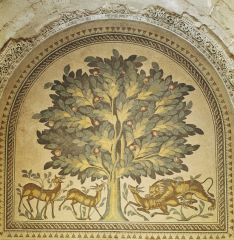
khirbat al-mafjar (diwan floor mosaic)
|
* umayyad (661-750)
* syria * palace of al-Walid II * mosiac floor reflects opulence of the dynasty * diwan mosaic is on elevated throne area. gold and silver teserae. figural representation of umayyad power. |
|
|
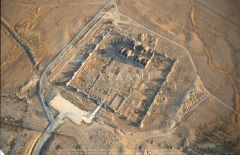
mshatta
|
* umayyad (661-750)
* syria * city/palace. residences for a ruler, al-Walid? Roman fortress exterior. Don't know function. Famous for massive size. |
|
|
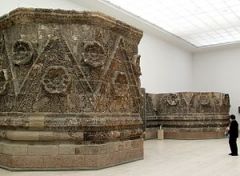
mshatta (stucco facade)
|
* umayyad (661-750)
* syria * carving into thickly plastered stucco. rosettes as overlay. vines, leaves, and confronted animals. unnatural representations of natural objects. reptition but with variation. usually painted post carving. workforce primarily indigenous christian population- vaguely christian imagery. $$$ powerpowerpower |
|
|
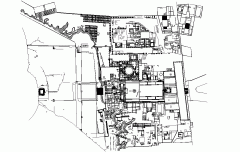
jausaq al-khaqani at samarra (floorplan)
|
* abbasids (750-1258)
* abbasids take Baghdad in 762, but unofficial capital is Samarra. Calephs build highly elaborate desert palaces along Tigris river. * many fantastic rooms.. hunting park, zoo, slaves with leopards, and other impressive displays. |
|
|
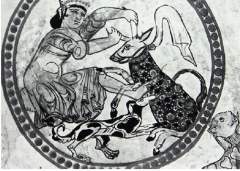
samarra huntress fresco
|
* abbasids (750-1258)
* abbasids take Baghdad in 762, but unofficial capital is Samarra. Calephs build highly elaborate desert palaces along Tigris river. * abbasids take on asiatic style in the ideal of beauty in human rendering. more perisan type. |
|
|
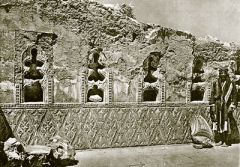
samarra style stucco
|
* abbasids (750-1258)
* abbasids take Baghdad in 762, but unofficial capital is Samarra. Calephs build highly elaborate desert palaces along Tigris river. * built quickly and in great numbers. stucco exterior decoration was quick and efficient. simplified by use of rolling pin-esque mechanism, stamp-like imprinting. |
|
|
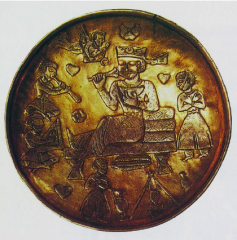
silver gilt dish with princely cycle
|
* abbasids (750-1258)
* prince seated, 3/4 profile, princely entertainments. heart is a sessanian emblem. princely cycle, hunting, falcones and trained leopards. calligraphy: wishes for good health, wealth, etc. *solid silver, covered in gold, refired and carved. ceramic dish for upper middle class- imitate objects that would be made for royalty. "democratization of the image" |
|
|
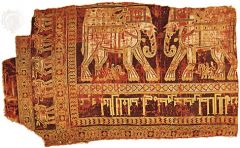
elephant silk (st. josse silk)
|
* abbasids (750-1258)
* taken by crusaders and preserved in church in the west. * naturalistic > unnatural * kufic calligraphy |
|
|
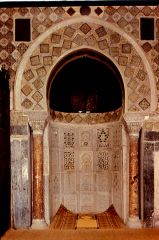
mihrab @ great mosque of quairawan
|
* abbasids (750-1258)
* lustre firing process, new technique, being made in baghdad. precious metals to decorate mihrab, tiles not aligned, orientation is not important. |
|
|

white slipware dish with kufic
|
* abbasids (750-1258)
* chinese porcelain, shows chinese influence and trade. dot in middle also borrowed from chinese art. not functional- meant to be displayed. |
|
|
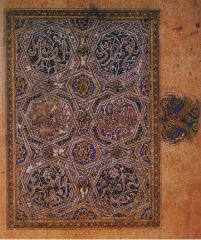
qur'an sura heading
|
* abbasids (750-1258)
* first qur'an that survives on paper, previously done on vellum. parchment paper comes from china. * decorative calligraphy details reflects sacredness of the object. artist notoriety- scribe puts name, name of patron, and word count of the qur'an. |
|
|
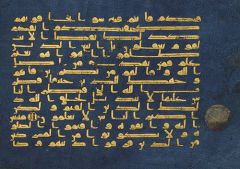
blue qur'an
|
* fatimid (921-1171)
* tendency towards imperial- trying to out do the caleph and the byzantine emperor. looking back to byzantine style for manuscript making. script becoming more graphic and decorative. |
|
|
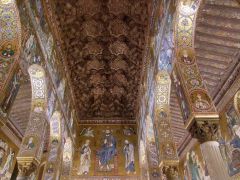
cappella palatina palermo
|
* fatimid (921-1171)
* sicily, italy * capital of medieval norman kingdom of sicily. founded by roger II- grand international court. abbasids vs. byzantine empire and crusaders, makes fatimids politically useful. *muqarnas vault or honeycomb vault. wooden ceiling. created by fatimid workshop. catholic church/ reception hall. also has byzantine mosaics. qur'an quotes in foliated kufic running the entire legnth of the ceiling. images are variations of princely entertainments, sense of whirling movement. |
|
|

al-aqmar mosque
|
* fatimid (921-1171)
* very wealthy would build there own mosques adjacent to houses/ schools. religious schools called madrasas- memorize qur'an. *emphasis on exterior is a fatimid tendency. muqarnes used as decoration. names of god and name of patron. |
|
|
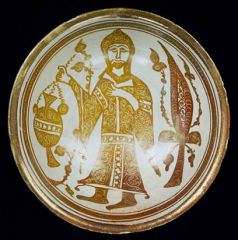
lustreware dish with coptic priest
|
* fatimid (921-1171)
* lustreware more affordable. democratization of the object. art of caliphate still and influence even though power shift- fatimid caliph. fatimids produced more lustreware with any other dynasty. *rise of artisan class- signed works. |
|
|
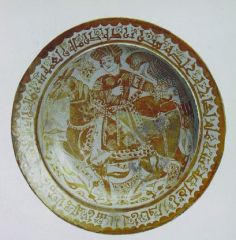
falconer dish
|
* fatimid (921-1171)
* fustat ware. kufic says "good health and good life to the owner, may he be saved from evil." apotropaic. * princely entertainments- democratization of the image and the object * compare to white slipware dish: content of description, style chinese vs. opulent fatimid/abbasid. |
|
|
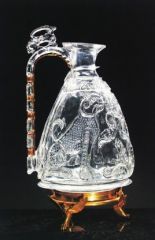
rock crystal ewer of al-aziz
|
* fatimid (921-1171)
* Most celebrated works of fatimid dynasty- things carved from rock crystal. lion/lopard, highly decorative in the carvings, caliphs name carved on top. used with wine or oil. gazelles drinking from fountain is an ancient muslim symbol. |
|
|

robe of honor - tiraz
|
* fatimid (921-1171)
* tiraz pre-date fatimids. strip of fabric given by caliph to high ranking court member to someone who has had great military successes etc. emblem of favor. |
|
|

bobrinsky bucket
|
* great saljuk (1037-1194)
* inlaid brass. used to store water during the hajj pilgrimage, but for someone who was very wealthy because this would not necessarily be a convenient item to carry along. * saljuks best known for their metal works. 1099 crusaders take jerusalem. merchant class associated with silk route, both the person who cast the form and the artist who decorated it are named. imagery is basically princely entertainments. anthropomorphic script. |
|
|
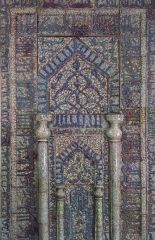
lustreware mihrab
|
* great saljuk (1037-1194)
* because the great saljuks were nomadic, they needed art that could be put together and taken apart. 1100 pieces. made for minor prince in saljuk dynsasty by a family of tileworkers. portability. script becomes as important as any other imagery. |
|
|
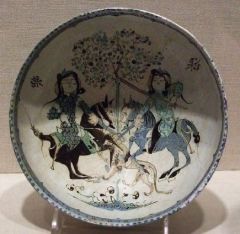
min'ai bowl with confronted horseman
|
* great saljuk (1037-1194)
* min'ai: colors applied under the glaze and over the glaze * saljuk art incorporates imagery from a mix of media. horseman replicated a type found in textiles, blending with princely entertainments, wearing contemporary saljuk costume. |
|
|
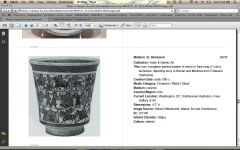
min'ai bowl with shahnama
|
* great saljuk (1037-1194)
* min'ai: colors applied under the glaze and over the glaze * illustrates passage from the book of kings: shanama. culture of persians, history. written by firdausi. military overtone. attention to contemporary life characteristic of saljuks. |
|
|
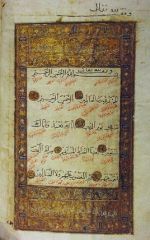
nashki qur'an
|
* great saljuk (1037-1194)
* naskhi is the language of the persians. signature of the writer and the painter, identifies himself as a shi'ite. arabic translations written in, living record of private ownership. |
|
|

gunbad-i quabus
|
* great saljuk (1037-1194)
* iran * conical roof because of heavy snows? or later addition? emphasis on brickwork. 175 feet high. brilliant turquoise glazed tiles. glass coffin suspended in it? head oriented to east. referencing burial rites of pre islamic fire religion- cross cultural weaving. emphasis on 1 facade: pishtaq. * tombs for military commanders, princes, some women. high status but not sultans, military and court aristocracy. * sunni, sufi: emphasis on mausolea |
|
|
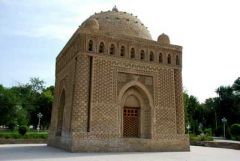
tomb of the samanids
|
* great saljuk (1037-1194)
* bakhura, uzbekistan * 4 identical facades, no pishtaq. over 72 patterns of brickwork on building. fortress type architecture. engaged columns on outside only. |
|
|

mausoleum of mu'mina khatun
|
* great saljuk (1037-1194)
* armenia * muqharnes vaults. shallow dome originally. pishtaq. cobalt and white glazed times. burial place of a princess. |
|
|

friday mosque at isfahan
|
* great saljuk (1037-1194)
* iran * acreted building complex. bazaar city center. started from abbasid t-plan mosque. articulated: able read the interior from the exterior form. use of domes is expressly saljuk. minarets opposite the quibla wall. enormous vault open on one side. 4 iwan plan. extreme emphasis on facade. entrance towards quibla wall is deeper and wider. |
|
|
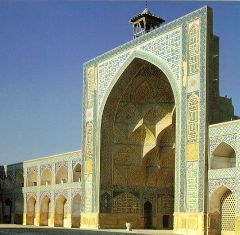
friday mosque at isfahan (pistaq)
|
* great saljuk (1037-1194)
* iran * acreted building complex. bazaar city center. started from abbasid t-plan mosque. articulated: able read the interior from the exterior form. use of domes is expressly saljuk. minarets opposite the quibla wall. enormous vault open on one side. 4 iwan plan. extreme emphasis on facade. entrance towards quibla wall is deeper and wider. |
|
|
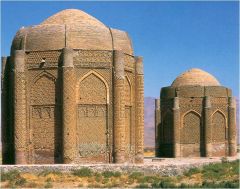
tomb towers at kharraquan
|
* great saljuk (1037-1194)
* kharraquan, iraq * tomb tower and domed square combined. symbolize saljuk tents. not for holy people, for the aristocracy. sultan buried as close to mihrab as possible, inside the friday mosque. |
|
|
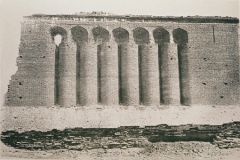
ribat al-malik caravanserai
|
* great saljuk (1037-1194)
* uzbekistan * state sponsored inns/trading center. no longer exists. monumental scale. silk road trade. brickwork. |
|
|
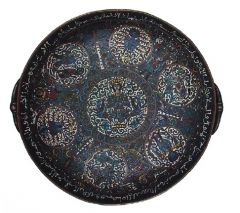
alexander plate
|
* atabeg (1100-1300) - artuqid
* comissioned for or by an artuqid prince, bears his name and titles in both arabic and persian. made in georgia. * enameled cloisonne. byzantine technique. * subject matter/iconography is mixed. alexander the great's ascension into heaven, "self engineering his apotheosis" via griffins. also has dancing girls, eagles, etc. but not whole princely entertainments. taking bits and pieces from different cultures. |
|
|
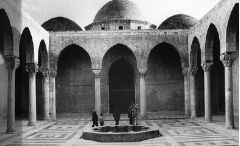
al-firdaus mosque and madrassa
|
* atabeg (1100-1300)- saljuks of rum (1235-1236)
* aleppo, syria * saljuks of rum employ armenian architects, but maintain great saljuk tendencies of state architecture (to emphasize power) , princely duties, minor arts. state sponsored royal school. patrons: royal women- type of dowry/currency. decoration becomes musch more limited but stone carving is typical of saljuks of rum. |
|
|
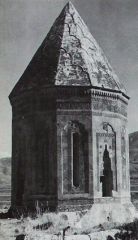
gevas tomb tower
|
* atabeg (1100-1300) - saljuks of rum (around 1300)
* gevas, turkey * royal princess. armenian architecture put into the service of saljuks of rum. muqarnes vaulting. different in scale. people in power adapting other groups ideas. |
|
|
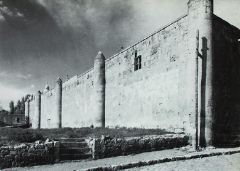
tercan caravanserai
|
* atabeg (1100-1300)
* tercan, turkey * silk road and slave trade. visual expressions of power. monumental in scale. change: caravanserais have religious focus, and no quasi-defensive aspects, actually functional. * great saljuk caravanserais: contrast with umayyads, use rather than display. no more fake militaristic features. |
|
|
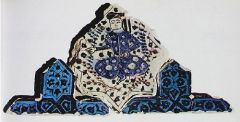
star tiles (from qubadabad)
|
* atabeg (1100-1300) - saljuks of rum
* qubadabad royal palace of the sultanate in konya, turkey * shape of tile, part of decoration, mineral colbat- expensive recourses of anatolian plateau. democratization of the image- seated ruler, generic. |
|
|
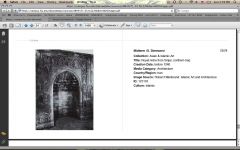
royal niche (at sinjar)
|
* atabeg (1100-1300)
* sinjar, iraq * ruler seated in royal niche, muqarnes vaulting forms canopy over head. pre existing religious form, religious/secular use, "slaves" : mamluks. most sacred space in mosque becomes emblem of secular power. little figures of court officers decorating the edges. |
|
|
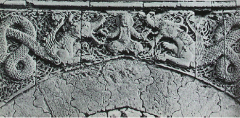
talisman gate
|
* atabeg (1100-1300)
* baghdad (now destroyed) * serpent/griffin. snakes become symbolic of power. influence from the east. now using haloes for rule/power, no sacred value. apotropaic: prevent evil, also protect from evil. |
|
|
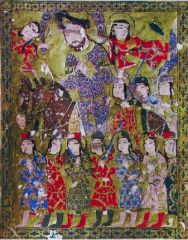
book of songs
|
* atabeg (1100-1300)
* secular texts, popular texts that pre-exist atabegs, written down and illustrated for the first time ever. workshops producing 20 volume set of book of songs. show of wealth. use of hieratic/hierarchic scale. haloes, tiraz (name on tiraz is his own name, identifier). byzantine influence angles? or roman victory figures? important people in this period: horseman. mounted armies, anatolia. members of the court wearing distinctive and lavish dress. upper nobility- not ruler. visual bring adapted by non-rulers. base material of entire piece is gold leaf. frontispiece of volumes. implements of power from all cultures. bright colors characteristic of this period. |
|
|
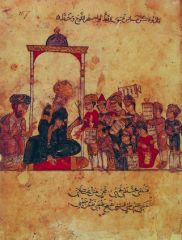
magamat
|
* atabeg (1100-1300)
* popular novel- no illustrations pre-atabeg.abu zaid shown in image and words beneath. lower class- mass produced. traveler who tries to do different jobs, preacher teacher- but he is a "fool." |
|
|
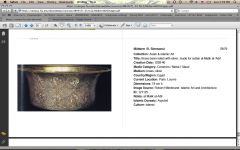
ayyubid brass basin
|
* atabeg (1100-1300) - ayyubid
* ayyubids have most interaction with crusaders. metalwork extremely unique. brass with silver inlay. statement of wealth for middle or upper middle class- shows the rise of this class. wealth of patron discussed in inscriptions. * imagery: princely entertainments, seated ruler, dancing girls. democratization of image. figures highly articulated/segmented. confronted animals. * inscriptions: laudatory but vague. place made and names of craftsmen. readymade not comission. |
|
|
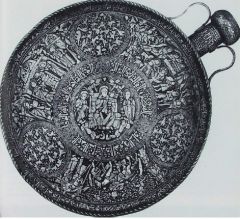
ayyubid brass canteen
|
* atabeg (1100-1300) - ayyubid
* 18 of these objects survive. echo form of crusader canteens. ayyubid metal works. * imagery: mary and christ in center, nativity scene. cruciform halo on christ. nativity, presentation, entry into jerusalem. "prophet jesus" not indicative of christ- crucifixion etc. sura around the sides, workshop name on spout. reaction against crusader art? no name of patron. mass produced. |
|

